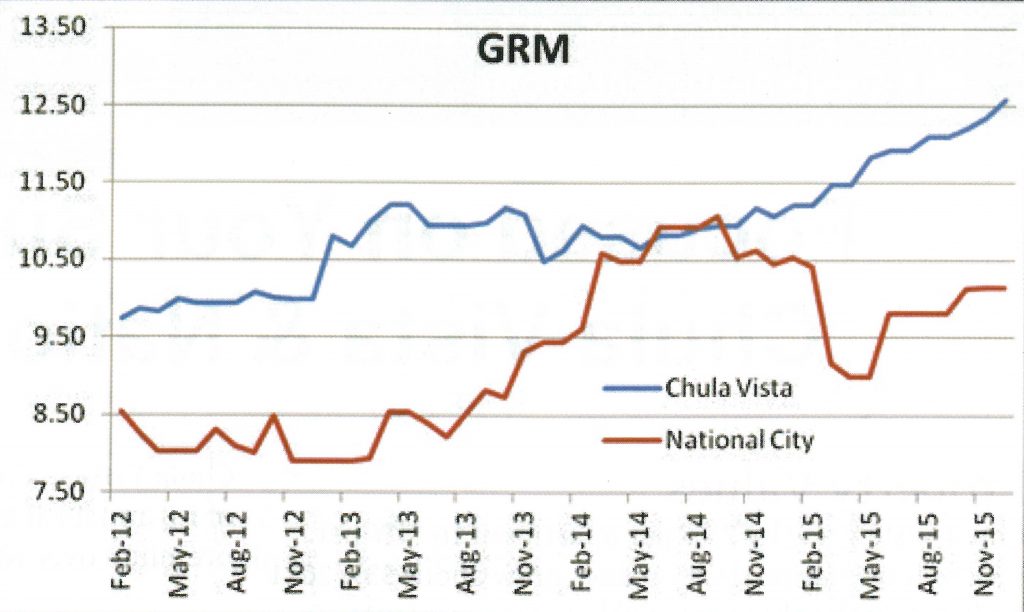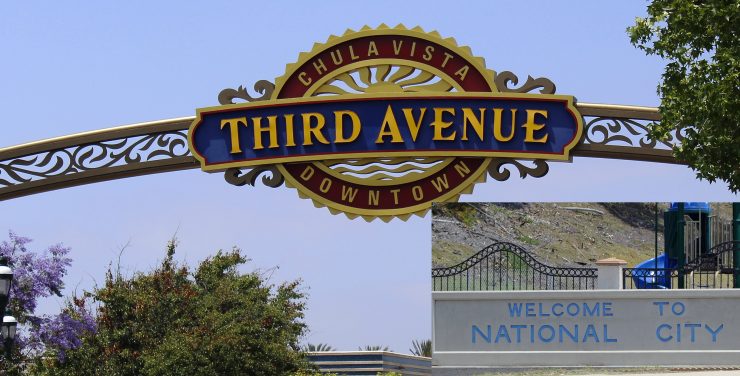ACI’s Terry Moore explores how you can find success in the areas of Chula Vista and National City.
Property Values
Chula Vista grew by 26% per apartment to 37% per square foot. National City values grew about 33% 2011 and 2015 in the three main value measurements.
Chula Vista
Properties in Chula Vista average 30 units, twice National City’s average of 14. Chula Vista has a higher percentage of two bedroom apartments. Most buildings in San Diego County with five to nineteen units have a majority of one bedrooms and or studios. Larger buildings have a majority of two and three bedrooms.
Chula Vista hosts the Chula Vista Nature Center, Otay Valley Regional Park, Sleep Train Amphitheater, OnStage Playhouse, the Chula Vista Marina, the U.S. Olympic Training Center and
Otay Lake Reservoir. Chula Vista plans to develop the bayfront. Small businesses and sensible local government provide stability and encourage growth and development.
Chula Vista is the most affluent city completely south of I-8 and its apartments usually commands 10%-20% premium over National City units.
[box] Chula Vista, “beautiful view,” is so named because of its scenic location between the San Diego Bay and coastal mountain foothills. Its population of 244,000 means it is the second biggest city in San Diego County and the seventh largest city in Southern California [/box]
National City
National City, with a population of 59,000 is the second-oldest city in San Diego County. National City is bounded by San Diego to the north and northeast, Bonita to the southeast, and Chula Vista to the south across the Sweetwater River. San Diego Bay lies to the immediate west of the city.

In 2012, National City was honored as the most walkable city in San Diego County. It currently holds a walk score of 71, and this score also put National City among bigger cities like Seattle, Washington (74) and Portland, Oregon (66). San Diego’s current walk score is 56. National City is one of three cities with a majority of the housing units being rentals. Imperial Beach and El Cajon are the other two cities. National City rental demographics are close to City Heights, Lemon Grove, San Ysidro and Spring Valley. Chula  Vista renters to have more education, slightly better credit scores, and modestly higher income. Look at the numbers – on a deeper level.
Vista renters to have more education, slightly better credit scores, and modestly higher income. Look at the numbers – on a deeper level.
As usual, we will analyze cost per apartment, cost per square foot of improvement, and gross rent multiple (how many years of rental income the buyer paid for property). From 2011- 2015,
I analyzed 37 National City sales and 44 Chula Vista transactions. Each data point on the graph represents the average of the previous 12 months, a moving average.
Appraisers use all three measures to determine value. These three measures show Chula Vista’s GRM has grown 28%, from 9.75 to 12.45; cost per unit increased from $123k to $154k, 26%; and cost per rentable square foot climbed from $143 to $196, or 37%. Averaging the three indicators makes a blended increase of 30%
National City changes were: 19% for GRM, from 8.54 to 10.15, 19% for dollar per square foot, from $143 to $170 and 62% for cost per apartment. Averaging the three indexes makes a blended rate of 33%. Those gains are good, but the real impact is even more impressive.
Most households who buy apartments obtain a loan. Suppose someone bought a million-dollar building in 2011. In Chula Vista they put down 30% and a National City buyer put down 25%.
For Chula Vista 30% down, an equity of $300k, needed a loan of $700k. If values climbed by 30%, the building could be worth $1300k today. The equity would be$ 635k ($1,300k value- $665k debt). That means the owner’s equity has more than doubled, equity has grown by 112%. That is grand!
Look to the south. The National City buyer put down 25%, $250k equity and borrowed $750k. For simplicity let’s assume that the National City property grew 33% in value and is worth $1,333,000 today. The loan has probably paid down to about $715,000. From $250,000 to $618,000, ($1,333,000 value- $715,000 debt). The increase is 147%, actually greater than Chula Vista!
Some investors are surprised when humbler areas deliver better returns than fancy zip codes. Lower down payment, greater leverage often grows equity faster in ordinary neighborhoods than in more affluent locations.
That’s out of the box financial success!
So much for history … what do you do now?
Regardless of where your equity spent the last decade, now put your equity where it’s most likely to give you the best result in the next generation.
Let’s take a longer view … a much longer view.
When she accepted SDCAA’s Lifetime Achievement Award, Linda Morris challenged us to live a life worth imitating. When we were younger we may not have thought much about legacy. Friends, sometime in the next hundred years you and I will be gone.
Your investment planning includes the inheritance you’ll leave behind, the keys, the cash, the property … the stuff. You’ll also leave a legacy.
Your legacy is what people can do because you were here. It includes your examples and the stories people tell about you. So, here’s my question for you:
Is your real estate equity promoting the legacy that you want to build? Will people remember you as someone who focused only on your comfort and convenience or as someone who also inspired and benefited others?
Closing reminders
As always, please save the article or articles which pertain to the areas are you own. As an SDCAA member, you’re entitled to receive a free estimate of value of your apartment building. That valuation is confidential and there’s no obligation. It’s part of our team’s focus on your success.
 About the author: Terry Moore is an owner of ACI, Apartment Consultants Inc, San Diego’s most active apartment brokerage. For seven years he was a Director of SDCAA. He and his wife, Sandy, have been rental owners for almost 40 years. Contact Terry at 619-889-1031, tmoore1031@gmail.com or SanDiegoApartmentBroker.com
About the author: Terry Moore is an owner of ACI, Apartment Consultants Inc, San Diego’s most active apartment brokerage. For seven years he was a Director of SDCAA. He and his wife, Sandy, have been rental owners for almost 40 years. Contact Terry at 619-889-1031, tmoore1031@gmail.com or SanDiegoApartmentBroker.com



